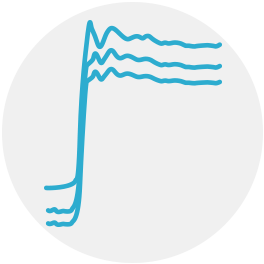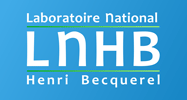X-ray fluorescence analysis techniques

The X-ray Reflectivity (XRR) and Grazing Incidence X-Ray Fluorescence (GIXRF) analysis techniques make it possible to characterize in depth samples of new nanostructured or thin-film materials used in various fields of applications: power electronics, solar photovoltaic energy, energy-efficient windows. This characterization is carried out by varying the angle of incidence of radiation on the sample and recording the reflected beam and/or the fluorescence emitted.
The specificity of the materials studied, in terms of dimensional structure and chemical composition, is a challenge for analytical methods. To answer this question, the X analysis methods (XRR, GIXRF, etc.) are used to gather as much information as possible (dimensional and structural) on the sample parameters.
The LNHB is developing these techniques and their implementing is carried out on the metrology beamline of the SOLEIL synchrotron, using a dedicated goniometer. The analysis of experimental data includes the detailed processing of fluorescence spectra with complex structure by mean of our Colegram software. All results must be processed using simulation codes in order to determine the parameters studied (element distribution profile, quantity deposited, density, chemical status, etc.).
REFERENCES:
– Y. Ménesguen and M.-C. Lépy, “Metrology of thin layer deposition with combined XRR-GIXRF analysis at SOLEIL”, Proc. SPIE 11611, Metrology, Inspection, and Process Control for Semiconductor Manufacturing XXXV, 116110I (22 February 2021)
DOI: 10.1117/12.2583702
– Y. Ménesguen and M.-C. Lépy, “Reference-Free Combined X-Ray Reflectometry – Grazing Incidence X-ray Fluorescence at the French Synchrotron SOLEIL” (2021) Physica Status Solidi A 2100423.
DOI: 10.1002/pssa.202100423
– S. Torrengo, D. Eichert, Y. Mazel, M. Bernard, Y. Ménesguen, M.-C. Lépy and E. Nolot, “Quantitative depth-profile analysis of transition metal nitride materials with combined grazing-incidence X-ray fluorescence and X-ray reflectometry analysis” (2020) Spectrochimica Acta Part B 171, 105926 E.
DOI: 10.1016/j.sab.2020.105926
– Nolot, W. Pessoa, S. Torrengo, Y. Mazel, M. Bernard, P. Gergaud, Y. Ménesguen, M.-C. Lépy and D. Eichert, “Grazing-incidence X-ray fluorescence analysis of thin chalcogenide materials deposited on Bragg mirrors” (2020) Spectrochimica Acta Part B 168, 105864.
DOI: 10.1016/j.sab.2020.105864
– W. Pessoa, A. Roule, E. Nolot, Y. Mazel, M. Bernard, M.-C. Lépy, Y. Ménesguen, A. Novikova, P. Gergaud, F. Brigidi, D. Eichert “Grazing incident X-ray fluorescence combined with X-ray reflectometry metrology protocol of telluride-based films using in-lab and synchrotron instruments” (2018) Spectrochimica Acta Part B, 149, 143-149
DOI: 10.1016/j.sab.2018.07.003
– H. Rotella, B. Caby, Y. Ménesguen, Y. Mazel, A. Valla, D. Ingerle, B. Detlefs, M.-C. Lépy, A. Novikova, G. Rodriguez, C. Streli, E. Nolot “Elemental depth profiling in transparent conducting oxide thin film by X-ray reflectivity and grazing incidence X-ray fluorescence combined analysis” (2017) Spectrochimica Acta Part B, 135, 22-28
DOI: 10.1016/j.sab.2017.06.011
– Y. Ménesguen, B. Boyer, H. Rotella, J. Lubeck, J. Weser, B. Beckhoff, D. Grötzsch, B. Kanngießer, A. Novikova, E. Nolot and M.-C. Lépy “CASTOR, a new instrument for combined XRR-GIXRF analysis at SOLEIL” (2016)
DOI: 10.1002/xrs.2742
Metrology of fundamental parameters
At the same time, metrological aspects are studied to ensure the quality of quantitative results. In particular, measurements of atomic parameters (mass attenuation coefficients, fluorescence yields) shall be carried out for the elements of interest and the values obtained compared with the values used in the calculation codes, and may be incorporated into them.
The experimental results of mass attenuation coefficients are available here: http://www.nucleide.org/Laraweb/Mu
REFERENCES:
– Y. Ménesguen and M.-C. Lépy, “Experimental determination of L fluorescence yields of gadolinium” (2020) X-Ray Spectrometry, 49, 596-602.
DOI: 10.1002/xrs.3157
– Y. Ménesguen, C. Dulieu and M.-C. Lépy, “Advances in the measurements of the mass attenuation coefficients” (2019) X-Ray Spectrometry, 48, 330–335.
DOI: 10.1002/xrs.2991
– Y. Ménesguen, M.-C. Lépy and B. Beckhoff, “New Measurements of X-ray Fundamental Parameters”, Spectroscopy, Vol. 33, 7, p.24
– Y. Ménesguen, M.-C. Lépy, Y. Ito, M. Yamashita, S. Fukushima, M. Polasik, K. Słabkowska, Ł. Syrocki, E. Wȩder, P. Indelicato, J.P. Marques, J.M. Sampaio, M. Guerra, F. Parente and J.P. Santos, “Precise X-ray energies of gadolinium determined by a combined experimental and theoretical approach” (2019) Journal of Quantitative Spectroscopy and Radiative Transfer, Volume 236, 106585.
DOI: 10.10163.j.jqsrt.2019.106585
– Y. Ménesguen, M.-C. Lépy, J. M. Sampaio, J. P. Marques, F. Parente, M. Guerra, P. Indelicato, J. P. Santos, P. Hönicke and B. Beckhoff, “A combined experimental and theoretical approach to determine X-ray atomic fundamental quantities of tin” (2018) X-Ray Spectrometry;47: 341–351.
DOI: 10.1002/xrs.2948
– Y. Ménesguen , M.-C. Lépy, P. Hönicke, M. Müller, R. Unterumsberger, B. Beckhoff, J. Hoszowska, J.-C. Dousse, W. Błachucki, Y. Ito, M. Yamashita and S. Fukushima, “Experimental determination of the X-ray atomic fundamental parameters of nickel” (2018) Metrologia 55, 56-66
DOI: 10.1088/1681-7575/aa9b12
– Y. Ménesguen, M.-C. Lépy, J. M. Sampaio, J. P. Marques, F. Parente, M. Guerra, P. Indelicato and J. P. Santos “Experimental and theoretical determination of the L-fluorescence yields of bismuth” (2018) Metrologia, 55, 621-630.
DOI: 10.1088/1681-7575/aad1d6
– Y. Ménesguen, M. Gerlach, B. Pollakowski, R. Unterumsberger, M. Haschke, B. Beckhoff and M.-C. Lépy “High accuracy experimental determination of copper and zinc mass attenuation coefficients in the 100 eV to 30 keV photon energy range” (2016) Metrologia, 53 (1), art.n° 7
DOI: 10.1088/0026-1394/53/1/7
COLLABORATIVE PROJECTS:
– ThinFilms (Traceable characterisation of thin-film materials for energy applications) – Website: http://projects.npl.co.uk/optoelectronic_films/
– ThinErgy (Traceable characterisation of thin-film materials for energy applications) – Website: http://www.ptb.de/emrp/thinergy.html
– 3DMetChemIT (Advanced 3D chemical metrology for innovative technologies) – Website: http://empir.npl.co.uk/3dmetchemit/
– Hymet (Hybrid metrology for thin films in energy applications)- Site : https://www.hymet.ptb.eu/
– Industrial projects REXDAB and REXDAB2
PARTNERSHIPS:
Institutional: PTB (Germany), Kyoto University (Japan), Freibourg University (Switzerland)
